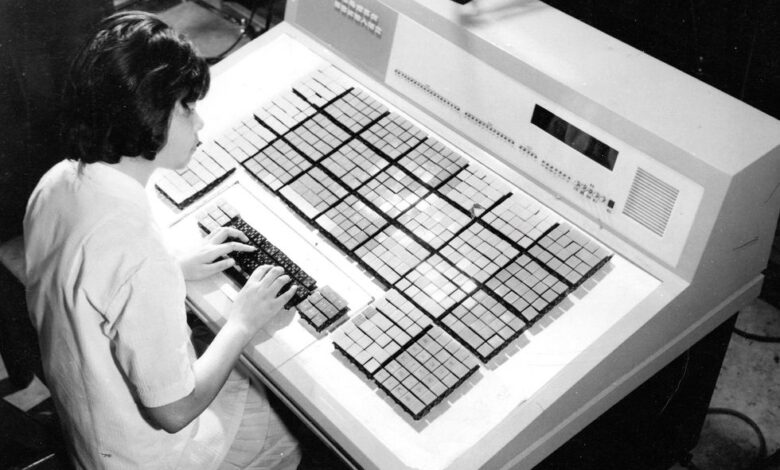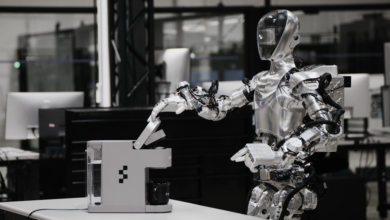The Forgotten History of Chinese Keyboards

“This will destroy China forever,” a young Taiwanese cadet thought as he sat in rapt attention. The renowned historian Arnold J. Toynbee was on stage, delivering a lecture at Washington and Lee University on “A Changing World in Light of History.” The talk plowed the professor’s favorite field of inquiry: the genesis, growth, death, and disintegration of human civilizations, immortalized in his magnum opus A Study of History. Tonight’s talk threw the spotlight on China.
China was Toynbee’s outlier: Ancient as Egypt, it was a civilization that had survived the ravages of time. The secret to China’s continuity, he argued, was character-based Chinese script. Character-based script served as a unifying medium, placing guardrails against centrifugal forces that might otherwise have ripped this grand and diverse civilization apart. This millennial integrity was now under threat. Indeed, as Toynbee spoke, the government in Beijing was busily deploying
Hanyu pinyin, a Latin alphabet–based Romanization system.
The Taiwanese cadet listening to Toynbee was Chan-hui Yeh, a student of electrical engineering at the nearby
Virginia Military Institute (VMI). That evening with Arnold Toynbee forever altered the trajectory of his life. It changed the trajectory of Chinese computing as well, triggering a cascade of events that later led to the formation of arguably the first successful Chinese IT company in history: Ideographix, founded by Yeh 14 years after Toynbee stepped offstage.
During the late 1960s and early 1970s, Chinese computing underwent multiple sea changes. No longer limited to small-scale laboratories and solo inventors, the challenge of Chinese computing was taken up by engineers, linguists, and entrepreneurs across Asia, the United States, and Europe—including Yeh’s adoptive home of Silicon Valley.
Chan-hui Yeh’s IPX keyboard featured 160 main keys, with 15 characters each. A peripheral keyboard of 15 keys was used to select the character on each key. Separate “shift” keys were used to change all of the character assignments of the 160 keys. Computer History Museum
The design of Chinese computers also changed dramatically. None of the competing designs that emerged in this era employed a QWERTY-style keyboard. Instead, one of the most successful and celebrated systems—the IPX, designed by Yeh—featured an interface with 120 levels of “shift,” packing nearly 20,000 Chinese characters and other symbols into a space only slightly larger than a QWERTY interface. Other systems featured keyboards with anywhere from 256 to 2,000 keys. Still others dispensed with keyboards altogether, employing a stylus and touch-sensitive tablet, or a grid of Chinese characters wrapped around a rotating cylindrical interface. It’s as if every kind of interface imaginable was being explored
except QWERTY-style keyboards.
IPX: Yeh’s 120-dimensional hypershift Chinese keyboard
Yeh graduated from VMI in 1960 with a B.S. in electrical engineering. He went on to Cornell University, receiving his M.S. in nuclear engineering in 1963 and his Ph.D. in electrical engineering in 1965. Yeh then joined IBM, not to develop Chinese text technologies but to draw upon his background in automatic control to help develop computational simulations for large-scale manufacturing plants, like paper mills, petrochemical refineries, steel mills, and sugar mills. He was stationed in IBM’s relatively new offices in San Jose, Calif.
Toynbee’s lecture stuck with Yeh, though. While working at IBM, he spent his spare time exploring the electronic processing of Chinese characters. He felt convinced that the digitization of Chinese must be possible, that Chinese writing could be brought into the computational age. Doing so, he felt, would safeguard Chinese script against those like Chairman Mao Zedong, who seemed to equate Chinese modernization with the Romanization of Chinese script. The belief was so powerful that Yeh eventually quit his good-paying job at IBM to try and save Chinese through the power of computing.
Yeh started with the most complex parts of the Chinese lexicon and worked back from there. He fixated on one character in particular:
ying 鷹 (“eagle”), an elaborate graph that requires 24 brushstrokes to compose. If he could determine an appropriate data structure for such a complex character, he reasoned, he would be well on his way. Through careful analysis, he determined that a bitmap comprising 24 vertical dots and 20 horizontal dots would do the trick, taking up 60 bytes of memory, excluding metadata. By 1968, Yeh felt confident enough to take the next big step—to patent his project, nicknamed “Iron Eagle.” The Iron Eagle project quickly garnered the interest of the Taiwanese military. Four years later, with the promise of Taiwanese government funding, Yeh founded Ideographix, in Sunnyvale, Calif.
A single key of the IPX keyboard contained 15 characters. This key contains the character zhong (中 “central”), which is necessary to spell “China.” MIT Press
The flagship product of Ideographix was the IPX, a computational typesetting and transmission system for Chinese built upon the complex orchestration of multiple subsystems.
The marvel of the IPX system was the keyboard subsystem, which enabled operators to enter a theoretical maximum of 19,200 Chinese characters despite its modest size: 59 centimeters wide, 37 cm deep, and 11 cm tall. To achieve this remarkable feat, Yeh and his colleagues decided to treat the keyboard not merely as an electronic peripheral but as a full-fledged computer unto itself: a microprocessor-controlled “intelligent terminal” completely unlike conventional QWERTY-style devices.
Seated in front of the IPX interface, the operator looked down on 160 keys arranged in a 16-by-10 grid. Each key contained not a single Chinese character but a cluster of 15 characters arranged in a miniature 3-by-5 array. Those 160 keys with 15 characters on each key yielded 2,400 Chinese characters.
The process of typing on the IPX keyboard involved using a booklet of characters used to depress one of 160 keys, selecting one of 15 numbers to pick a character within the key, and using separate “shift” keys to indicate when a page of the booklet was flipped. MIT Press
Chinese characters were not printed on the keys, the way that letters and numbers are emblazoned on the keys of QWERTY devices. The 160 keys themselves were blank. Instead, the 2,400 Chinese characters were printed on laminated paper, bound together in a spiral-bound booklet that the operator laid down flat atop the IPX interface.The IPX keys weren’t buttons, as on a QWERTY device, but pressure-sensitive pads. An operator would push down on the spiral-bound booklet to depress whichever key pad was directly underneath.
To reach characters 2,401 through 19,200, the operator simply turned the spiral-bound booklet to whichever page contained the desired character. The booklets contained up to eight pages—and each page contained 2,400 characters—so the total number of potential symbols came to just shy of 20,000.
For the first seven years of its existence, the use of IPX was limited to the Taiwanese military. As years passed, the exclusivity relaxed, and Yeh began to seek out customers in both the private and public sectors. Yeh’s first major nonmilitary clients included Taiwan’s telecommunication administration and the National Taxation Bureau of Taipei. For the former, the IPX helped process and transmit millions of phone bills. For the latter, it enabled the production of tax return documents at unprecedented speed and scale. But the IPX wasn’t the only game in town.
Loh Shiu-chang, a professor at the Chinese University of Hong Kong, developed what he called “Loh’s keyboard” (Le shi jianpan 樂氏鍵盤), featuring 256 keys. Loh Shiu-chang
Mainland China’s “medium-sized” keyboards
By the mid-1970s, the People’s Republic of China was far more advanced in the arena of mainframe computing than most outsiders realized. In July 1972, just months after the famed tour by U.S. president Richard Nixon, a veritable blue-ribbon committee of prominent American computer scientists
visited the PRC. The delegation visited China’s main centers of computer science at the time, and upon learning what their counterparts had been up to during the many years of Sino-American estrangement, the delegation was stunned.
But there was one key arena of computing that the delegation did not bear witness to: the computational processing of Chinese characters. It was not until October 1974 that mainland Chinese engineers began to dive seriously into this problem. Soon after, in 1975, the newly formed Chinese Character Information Processing Technology Research Office at
Peking University set out upon the goal of creating a “Chinese Character Information Processing and Input System” and a “Chinese Character Keyboard.”
The group evaluated more than 10 proposals for Chinese keyboard designs. The designs fell into three general categories: a large-keyboard approach, with one key for every commonly used character; a small-keyboard approach, like the QWERTY-style keyboard; and a medium-size keyboard approach, which attempted to tread a path between these two poles.
Peking University’s medium-sized keyboard design included a combination of Chinese characters and character components, as shown in this explanatory diagram. Public Domain
The team leveled two major criticisms against QWERTY-style small keyboards. First, there were just too few keys, which meant that many Chinese characters were assigned identical input sequences. What’s more, QWERTY keyboards did a poor job of using keys to their full potential. For the most part, each key on a QWERTY keyboard was assigned only two symbols, one of which required the operator to depress and hold the shift key to access. A better approach, they argued, was the technique of “one key, many uses”— yijian duoyong—assigning each key a larger number of symbols to make the most use of interface real estate.
The team also examined the large-keyboard approach, in which 2,000 or more commonly used Chinese characters were assigned to a tabletop-size interface. Several teams across China worked on various versions of these large keyboards. The Peking team, however, regarded the large-keyboard approach as excessive and unwieldy. Their goal was to exploit each key to its maximum potential, while keeping the number of keys to a minimum.
After years of work, the team in Beijing settled upon a keyboard with 256 keys, 29 of which would be dedicated to various functions, such as carriage return and spacing, and the remaining 227 used to input text. Each keystroke generated an 8-bit code, stored on punched paper tape (hence the choice of 256, or 28, keys). These 8-bit codes were then translated into a 14-bit internal code, which the computer used to retrieve the desired character.
In their assignment of multiple characters to individual keys, the team’s design was reminiscent of Ideographix’s IPX machine. But there was a twist. Instead of assigning only full-bodied, stand-alone Chinese characters to each key, the team assigned a mixture of both Chinese characters and character components. Specifically, each key was associated with up to four symbols, divided among three varieties:
full-body Chinese characters (limited to no more than two per key)partial Chinese character components (no more than three per key)the uppercase symbol, reserved for switching to other languages (limited to one per key)
In all, the keyboard contained 423 full-body Chinese characters and 264 character components. When arranging these 264 character components on the keyboard, the team hit upon an elegant and ingenious way to help operators remember the location of each: They treated the keyboard as if it were a Chinese character itself. The team placed each of the 264 character components in the regions of the keyboard that corresponded to the areas where they usually appeared in Chinese characters.
In its final design, the Peking University keyboard was capable of inputting a total of 7,282 Chinese characters, which in the team’s estimation would account for more than 90 percent of all characters encountered on an average day. Within this character set, the 423 most common characters could be produced via one keystroke; 2,930 characters could be produced using two keystrokes; and a further 3,106 characters could be produced using three keystrokes. The remaining 823 characters required four or five keystrokes.
The Peking University keyboard was just one of many medium-size designs of the era. IBM created its own 256-key keyboard for Chinese and Japanese. In a design reminiscent of the IPX system, this 1970s-era keyboard included a 12-digit keypad with which the operator could “shift” between the 12 full-body Chinese characters outfitted on each key (for a total of 3,072 characters in all). In 1980, Chinese University of Hong Kong professor Loh Shiu-chang developed what he called “Loh’s keyboard” (Le shi jianpan 樂氏鍵盤), which also featured 256 keys.
But perhaps the strangest Chinese keyboard of the era was designed in England.
The cylindrical Chinese keyboard
On a winter day in 1976, a young boy in Cambridge, England, searched for his beloved Meccano set. A predecessor of the American Erector set, the popular British toy offered aspiring engineers hours of modular possibility. Andrew had played with the gears, axles, and metal plates recently, but today they were nowhere to be found.
Wandering into the kitchen, he caught the thief red-handed: his father, the Cambridge University researcher Robert Sloss. For three straight days and nights, Sloss had commandeered his son’s toy, engrossed in the creation of a peculiar gadget that was cylindrical and rotating. It riveted the young boy’s attention—and then the attention of the
Telegraph-Herald, which dispatched a journalist to see it firsthand. Ultimately, it attracted the attention and financial backing of the U.K. telecommunications giant Cable & Wireless.
Robert Sloss was building a Chinese computer.
The elder Sloss was born in 1927 in Scotland. He joined the British navy, and was subjected to a series of intelligence tests that revealed a proclivity for foreign languages. In 1946 and 1947, he was stationed in Hong Kong. Sloss went on to join the civil service as a teacher and later, in the British air force, became a noncommissioned officer. Owing to his pedagogical experience, his knack for language, and his background in Asia, he was invited to teach Chinese at Cambridge and appointed to a lectureship in 1972.
At Cambridge, Sloss met Peter Nancarrow. Twelve years Sloss’s junior, Nancarrow trained as a physicist but later found work as a patent agent. The bearded 38-year-old then taught himself Norwegian and Russian as a “hobby” before joining forces with Sloss in a quest to build an automatic Chinese-English translation machine.
In 1976, Robert Sloss and Peter Nancarrow designed the Ideo-Matic Encoder, a Chinese input keyboard with a grid of 4,356 keys wrapped around a cylinder. PK Porthcurno
They quickly found that the choke point in their translator design was character input— namely, how to get handwritten Chinese characters, definitions, and syntax data into a computer.
Over the following two years, Sloss and Nancarrow dedicated their energy to designing a Chinese computer interface. It was this effort that led Sloss to steal and tinker with his son’s Meccano set. Sloss’s tinkering soon bore fruit: a
working prototype that the duo called the “Binary Signal Generator for Encoding Chinese Characters into Machine-compatible form”—also known as the Ideo-Matic Encoder and the Ideo-Matic 66 (named after the machine’s 66-by-66 grid of characters).
Each cell in the machine’s grid was assigned a binary code corresponding to the X-column and the Y-row values. In terms of total space, each cell was 7 millimeters squared, with 3,500 of the 4,356 cells dedicated to Chinese characters. The rest were assigned to Japanese syllables or left blank.
The distinguishing feature of Sloss and Nancarrow’s interface was not the grid, however. Rather than arranging their 4,356 cells across a rectangular interface, the pair decided to wrap the grid around a rotating, tubular structure. The typist used one hand to rotate the cylindrical grid and the other hand to move a cursor left and right to indicate one of the 4,356 cells. The depression of a button produced a binary signal that corresponded to the selected Chinese character or other symbol.
The Ideo-Matic Encoder was completed and delivered to Cable & Wireless in the closing years of the 1970s. Weighing in at 7 kilograms and measuring 68 cm wide, 57 cm deep, and 23 cm tall, the machine garnered industry and media attention. Cable & Wireless purchased rights to the machine in hopes of mass-manufacturing it for the East Asian market.
QWERTY’s comeback
The IPX, the Ideo-Matic 66, Peking University’s medium-size keyboards, and indeed all of the other custom-built devices discussed here would soon meet exactly the same fate—oblivion. There were changes afoot. The era of custom-designed Chinese text-processing systems was coming to an end. A new era was taking shape, one that major corporations, entrepreneurs, and inventors were largely unprepared for. This new age has come to be known by many names: the software revolution, the personal-computing revolution, and less rosily, the death of hardware.
From the late 1970s onward, custom-built Chinese interfaces steadily disappeared from marketplaces and laboratories alike, displaced by wave upon wave of Western-built personal computers crashing on the shores of the PRC. With those computers came the resurgence of QWERTY for Chinese input, along the same lines as the systems used by Sinophone computer users today—ones mediated by a software layer to transform the Latin alphabet into Chinese characters. This switch to typing mediated by an input method editor, or IME, did not lead to the downfall of Chinese civilization, as the historian Arnold Toynbee may have predicted. However, it did fundamentally change the way Chinese speakers interact with the digital world and their own language.
This article appears in the June 2024 print issue.
IEEE Spectrum




